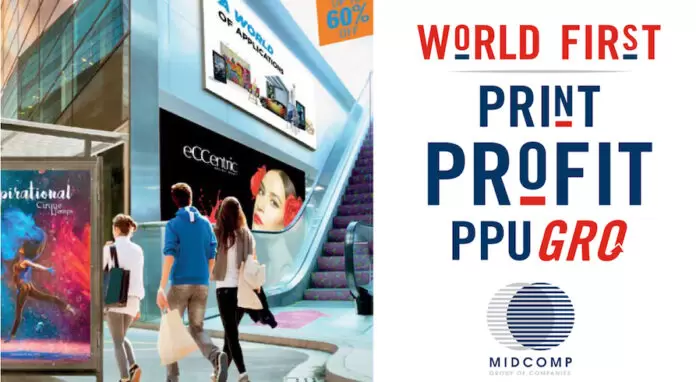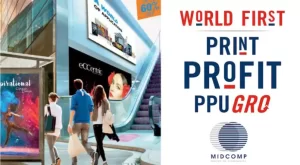Midcomp Launches World First PPUGRO System. Midcomp has launched the world’s first Pay Per Use system for entry level and low volume production printers that includes all of the printer consumables (excluding media) and service costs and also includes the cost of the printing equipment. With PPUGRO, PPU stands for Pay Per Use and GRO reflects the company promise: Catalyst for Growth.
This article originally appeared in: Sign Africa.
‘The programme enables companies to focus on making money from their printing systems while Midcomp focuses on enabling their customers’ business with the best technology available. Instead of spending time focusing on the asset (printing system), users should rather focus on what profit the asset can generate for their business.
Midcomp first introduced their Pay Per Use (PPU) programme three years ago. Under this programme, they cover all HP Latex printer consumables* and service costs into a fixed cost per square metre.
Under their PPU contract, it is one invoice per month and one payment per month, it is that simple. There are no purchase orders required per delivery of consumables* or service, it is all covered under the contract. In high print volume cases, they will issue consignment stock so that there is no lead time to receive consumables*. Accompanying the invoice is a detailed list of all the print jobs a user performed on the printer in the preceding month.
Midcomp customer feedback about the PPU programme:
‘In the print industry, sometimes calculating the costs can be difficult, as sometimes you can get a print that is filled with ink, and sometimes there is hardly any ink used, but the PPU programme has made it simple for us to accurately work out costs. Due to my distance, Midcomp has allowed me to keep a set of inks and printheads, so my printer is never offline and can always continue printing. Midcomp truly has paid attention to all my needs,’ said Mohammed Sheth, Director at Navii.
‘The unique PPU option that we took when we bought the printer gives you such peace of mind that you do not have to worry about ink, service charges, repairs and parts,’ said Print Corp owners Charlene and JP Pretorius.
‘The biggest benefit (of the PPU system) will come when our machine needs to have its service maintenance intervals, as these are expensive. With PPU, these service maintenance kits are included in the square metre cost. This avoids large amounts of cash outlays, as you never know what situation you will be in. Cost per square metre is cheaper on the PPU than my cost per square metre on my previous generation of printers,’ said Mathew Wilkinson, director at Mint Wrapworks.
The biggest advantage of HP Latex printers that allows Midcomp to create such a predictable scenario is that the printhead is a consumables* item and changed on a regular basis by a printer operator, unlike competitive printers where the printhead is a very expensive spare part that needs a qualified engineer to install or change.
The printhead is the most crucial element in any digital printing system because its condition determines print quality. So three, four or five-year-old printers that have been on Midcomp’s PPU programme will print like a brand new printer because Midcomp is contractually obliged to keep the printer in an ‘as new’ condition. This programme is hugely popular because of the certainty of print cost, with no guess work on the cost of printing a job. There is no need to see the artwork before determining the print cost.
The roll out of the PPU programme was an interesting journey for Midcomp and their customers. The majority of the early adopters of this programme were the company’s, and their competitors’, existing customers.
Why would this be? They were certainly vindicated in their beliefs early on in the programme as to just how disruptive it is for a print shop to be faced with an unexpected, poorly timed, and mostly inexplicably expensive breakdown of their printer.
• Unexpected because it always happens when a customer least expects it, Murphy makes sure of that.
• Poorly timed because it tends to happen when a customer is relying most on the printer to finish that super important client print job.
• Inexplicably expensive because most manufacturers today favour component assembly swap out rather than discreet component swap or repair. Not too many printer engineers move around with an oscilloscope to diagnose errors to the individual components. It is quicker and easier to change an entire component assembly and unfortunately the customer bears that cost.
First time HP Latex printer owners tended to see a different value chain in the PPU programme. Midcomp’s Innovation Hub has an enviable array of equipment, including a range of 1.6m wide HP Latex printers and HP Latex print and cut solutions; 3.2m wide roll to roll printers; flatbed printers; dye sublimation printers and heat presses; pigment ink printers for cotton printing; an industrial digital Zünd cutter for cutting flexible and rigid media; laminating equipment and an object printer. This facility and the equipment therein is used primarily as a demonstration and testing environment but also acts as a disaster recovery and an excess capacity service to their PPU and PPUGRO customers.
So an investment in an HP Latex printer on PPU or PPUGRO with Midcomp, or conversion of an existing HP Latex printer onto PPU, grants customers access to this R15 million facility.
When starting a new printing venture or deciding to in-source print work, it is comforting to know that a customer can start small and rely on Midcomp to plug the gap for them when they either incur machine downtime or they run out of capacity to finish the last minute rush jobs that tend to rule their lives.
Introducing PPUGRO
The most frequently asked question from Midcomp’s existing, and potential, PPU customers is somewhat obvious: ‘Can your PPU programme also include the printing system?’
Fair question, but think about it. Midcomp’s existing PPU system does not impose any minimum printing volume. If a user doesn’t print, they are not using printer consumables* or services, so it is a no win, no lose situation for both Midcomp and the customer. Under this programme, it is OK to have some very low volume print months. At the end of the day, a user only pays for the print they actually produce.
Now try including the cost of a printing system into that equation. How does Midcomp achieve a recovery on the cost of the printing system if a user prints minimal, or no quantity even if just for one month? The inevitable discussion of minimum print volumes arises. From Midcomp’s extensive research and discussions with customers, minimum print volumes per se are inherently unpopular. The pressure on Midcomp was to find another way to recover the capital cost into a PPU structure.
This led to the launch of the world-first PPUGRO. In this way, Midcomp is taking things to the next level as part of their aim to always innovate to make their customers’ lives simpler and better. How did they achieve this? Instead of a fixed minimum charge, they now offer a tiered, or variable, cost per square metre based on the volume actually printed in the month to be billed or invoiced.
The more a user prints, the less they pay per square metre. The less they print, the more they pay per square metre. But now a customer’s printer (and cutter/heat press if applicable) and RIP software plus all printer consumables* and service costs are covered under this tiered rate system.
An example: an HP Latex 315 print and cut system, which includes an HP Latex 315 printer (1.37m wide), an HP 1.4m vinyl cutter, SAi RIP software, all printer consumables*, spare parts, labour and travel as well as production access to Midcomp’s Innovation Hub, is as little as R44 per square metre.
The PPUGRO solution means Midcomp will install a printing system at a customer’s premises and simply charge them a predetermined variable rate per square metre that the customer prints. At the end of every month, a customer will be sent a spreadsheet detailing the jobs they have printed in that month as well as the total square metres printed. Midcomp applies the variable rate per square metre and sends a customer one invoice.
For a customer to qualify for this programme, certain criteria apply. A customer’s geographical location, their company size and turnover and their financial position will all affect their eligibility. The application would be subject to credit approval. Their partner in this venture, like Midcomp, see the profit generating potential for the printing equipment in the right hands, so approvals of applications for PPUGRO would inevitably be more likely than in the case of a straight rental application.
Welcome to the new world. Think about this: iTunes and CD sales are dead but Apple Music is thriving. Why should users be limited to the selection of music they happen to have in their library? Apple Music allows users to listen to what they want, when they want. Shifting to a ‘usage’ model is a global and cross generational trend. Research reveals that in the USA, 70% of adults use subscription services, up from 50% a few years ago. One also needs to quickly realise that when one’s revenue, and therefore profitability, is tied to usage and uptimes, one cannot afford downtime. Midcomp’s Innovation Hub should significantly enhance a customer’s uptimes.
Now customers have a printer supplier in Midcomp that uniquely understands how they can focus on maximising profitability. While others will pay lip service to that, Midcomp puts their money where their mouth is by maintaining a fully staffed R15 million production facility that is available to their PPU and PPUGRO customers to ensure every job a customer undertakes gets done right and on time. Their 13 factory trained engineers not only keep abreast of the latest industrial printing and finishing technology but also lead the industry with the best skills and expertise in colour management and production workflow. Every aspect of Midcomp’s business is geared towards enabling their customers’ success and growth.’

